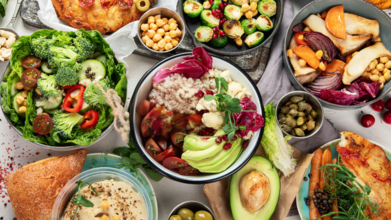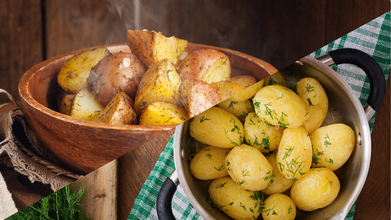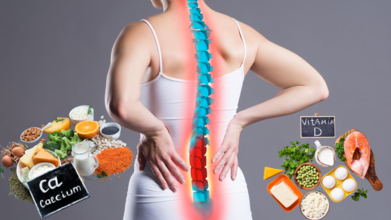- Health Conditions A-Z
- Health & Wellness
- Nutrition
- Fitness
- Health News
- Ayurveda
- Videos
- Medicine A-Z
- Parenting
- Web Stories
Going Vegetarian Could Cut Your Cancer Risk By 45%, Large Study Reveals

Credits: Canva
From cardiovascular health to more restful sleep, diets full of fruits, vegetables, legumes, and whole grains have repeatedly been connected with improved health. But now, new evidence indicates that a vegetarian diet might dramatically lower the risk of some cancers — in a few instances, by almost half.
A large, long-term study in the American Journal of Clinical Nutrition found that study participants who were vegetarians had a 45% lower risk of developing stomach cancer and a 25% lower risk of developing lymphomas than non-vegetarians. The combined overall risk reduction for all cancers was 12%.
The study team, whose leader is epidemiologist Gary Fraser from Loma Linda University in the US, examined health information from 79,468 Seventh-day Adventists in Canada and the US. Participants, initially cancer-free, were followed between 2002 and 2015.
Seventh-day Adventists are a unique group for studying diet and disease. Many avoid alcohol, tobacco, and unhealthy lifestyle habits, which helps control for factors that might otherwise skew results. Even so, Fraser noted that many non-vegetarian participants were still health-conscious — making the differences between the groups even more striking.
Why the Digestive System Sees Vegetarian Diet As The Biggest Benefit?
The most pronounced reductions in cancer risk were in cancers of the gastrointestinal tract — particularly stomach cancer. According to Fraser’s team, this makes sense biologically.
These organs have direct, repeated contact with the foods we eat and the byproducts of digestion. Compounds from processed meats, for instance, are established risk factors for stomach cancer. On the flip side, a diet high in fruits, vegetables, and fiber-rich plant foods supports a healthier gut environment, reduces inflammation, and can help protect against cellular damage.
Specific foods, such as citrus fruits, have been shown to play a protective role. Grilled and barbecued meats, on the other hand, can create compounds that increase cancer risk.
Does It Protect Against All Types of Cancers?
While the data strongly supported lower risks for stomach and lymphoma cancers, results for other cancers — such as lung, ovarian, and pancreatic — were promising but not statistically conclusive. There was no clear evidence that vegetarianism reduced the risk of cancers affecting the urinary tract or nervous system.
Fraser points out that the trends may still be meaningful and warrant further research. “The evidence was suggestive of lower risk in vegetarians, but did not quite reach the necessary standard to say more,” he said.
Is This A Vegetarian Advantage Or Just Healthier Living?
A fair question is whether it’s truly the lack of meat that protects vegetarians, or the fact that people who avoid meat often engage in other healthy behaviors like exercising regularly, not smoking, and maintaining a healthy weight. The study design helps minimize these confounding factors but cannot eliminate them entirely.
Still, there’s a growing body of research showing a direct relationship between lower consumption of animal products — especially red and processed meats — and reduced cancer risk.
Why Balance Is Essential?
While the benefits are compelling, Fraser and other experts stress that a vegetarian diet is not automatically healthy. Poorly planned vegetarian diets can lead to deficiencies in vitamin B12, iron, zinc, omega-3 fatty acids, and protein. For people in food deserts or those with limited access to fresh produce, making a vegetarian diet work can be challenging.
The takeaway from this study isn’t necessarily that everyone must go fully vegan or vegetarian overnight. Instead, the message is clear: shifting toward a more plant-forward diet, rich in fruits, vegetables, legumes, and whole grains, can have measurable health benefits.
As Fraser summed it up, “Adding more vegetables to your plate is the most important takeaway from this and similar studies.”
A Simple, Healthy Vegetarian Diet Plan for One Week
This plan balances nutrients, ensures adequate protein, and uses widely accessible foods.
Day 1
Breakfast: Oatmeal with almond milk, chia seeds, blueberries, and walnuts
Lunch: Lentil soup with whole-grain bread and side salad (spinach, tomatoes, cucumbers, olive oil dressing)
Dinner: Chickpea curry with brown rice and steamed broccoli
Snack: Apple slices with peanut butter
Day 2
Breakfast: Greek yogurt with banana, flaxseeds, and a drizzle of honey
Lunch: Quinoa salad with black beans, corn, avocado, and lime dressing
Dinner: Grilled vegetable stir-fry with tofu and soba noodles
Snack: Carrot sticks with hummus
Day 3
Breakfast: Smoothie with spinach, mango, protein powder, and oat milk
Lunch: Whole-wheat pita stuffed with falafel, lettuce, tomat, and tahini sauce
Dinner: Baked sweet potato topped with black bean chili and avocado slices
Snack: Mixed nuts and dried fruit
Day 4
Breakfast: Whole-grain toast with mashed avocado and poached egg
Lunch: Mushroom and spinach risotto made with vegetable broth
Dinner: Zucchini noodles with marinara sauce, lentil “meatballs,” and a side of roasted Brussels sprouts
Snack: Fresh strawberries with dark chocolate squares
Day 5
Breakfast: Overnight oats with cinnamon, pumpkin seeds, and diced pears
Lunch: Roasted vegetable wrap with hummus
Dinner: Thai-style coconut curry with mixed vegetables and tofu over jasmine rice
Snack: Cucumber slices with tzatziki dip
Day 6
Breakfast: Scrambled eggs with spinach and tomatoes, served with whole-grain toast
Lunch: Chickpea and spinach salad with lemon vinaigrette
Dinner: Eggplant parmesan with a side of quinoa and green beans
Snack: A peach or nectarine
Day 7
Breakfast: Smoothie bowl with blended banana, berries, almond butter, and granola topping
Lunch: Brown rice sushi rolls with cucumber, avocado, and pickled ginger
Dinner: Lentil shepherd’s pie with a mashed cauliflower topping
Snack: Roasted edamame with sea salt
Boiled vs Cooled Potatoes: How Resistant Starch Affects Your Glycemic Index

Credits: Canva
Potatoes are the quiet chameleons of the culinary world. They slip onto our plates in every possible form—creamy mashed with gravy, golden fries next to a burger, baked with a dollop of sour cream, or tossed into a chilled potato salad. They’re inexpensive, easy to grow, and endlessly adaptable, which is why they’ve long been a staple in homes across the United States and beyond but not all potatoes are created equal when it comes to health—especially when it comes to how they affect your blood sugar. The difference can come down to how they’re cooked, cooled, and the amount of resistant starch they hold.
There was a time when fresh potatoes were served at dinner almost daily in the average American household. Over the past few decades, though, their popularity has declined while processed potato products—French fries, chips, frozen wedges—have taken center stage.
Health experts often point out that despite technically being a vegetable, potatoes shouldn’t always be counted in the same category as leafy greens or cruciferous vegetables when building a balanced plate. The reasoning is simple: their nutrient profile is different, with less fiber and fewer micronutrients per calorie than vegetables like spinach or broccoli.
A medium potato with its skin intact provides about 2–3 grams of fiber and around 600 mg of potassium. But here’s the catch—boiling and other wet cooking methods cause some potassium to leach out. That’s why preparation matters.
Potatoes are rich in carbohydrates, mostly in the form of starch. The main type, amylopectin, breaks down quickly into glucose, causing a spike in blood sugar—a hallmark of foods with a high glycemic index. That’s why mashed potatoes or fries can cause a sharper blood sugar rise than, say, lentils or quinoa.
There’s also amylose, a type of starch that digests more slowly. The starches that resist digestion—appropriately named resistant starch—act more like dietary fiber, passing through the small intestine undigested and reaching the large intestine where they feed beneficial gut bacteria. Here’s where the cooking method comes in:
Baking and microwaving potatoes generally preserve more resistant starch than boiling.
Boiling, then cooling potatoes, significantly increases their resistant starch content.
New or young potatoes, harvested before full maturity, naturally have more amylose than older, fully mature potatoes.
Why Cooling Changes the Effect Potatoes Have On Our Health?
When a potato is boiled, its starch granules gelatinize, making them more digestible. But if you allow the potato to cool completely—like you would for a potato salad—some of those gelatinized starches reorganize into a crystalline form that resists digestion. This process, known as retrogradation, increases the amount of resistant starch.
This means that the same potato can have a lower glycemic index when eaten cold compared to hot. Lower glycemic index foods cause a slower, steadier rise in blood sugar, which may help reduce spikes that contribute to insulin resistance over time.
Benefits of Resistant Starch Beyond Blood Sugar
Resistant starch doesn’t just help flatten your post-meal blood sugar curve—it has a ripple effect across several aspects of health:
Gut health – Acts as a prebiotic, feeding beneficial bacteria in the colon.
Short-chain fatty acids – Fermentation of resistant starch produces compounds like butyrate, which support colon health and may protect against digestive disorders.
Inflammation – Potentially reduces gut inflammation by improving barrier function.
Metabolic health – Studies suggest improved insulin sensitivity and reduced fasting blood glucose in people with type 2 diabetes and obesity.
In a review of 15 clinical trials, participants consuming around 30–40 grams of resistant starch daily had lower fasting blood sugar levels, while just 10 grams a day lowered fasting insulin levels.
Potatoes vs. Whole Grains
Potatoes are often served in the same role as bread or rice—a starchy base for a meal. But nutritionally, swapping potatoes for whole grains can be a healthier choice in many cases. Whole grains consistently show stronger links to lower risk of heart disease, type 2 diabetes, and overall mortality.
This doesn’t mean potatoes are off-limits. It simply means portion size, preparation, and what you serve them with matters. Pairing them with healthy fats like olive oil instead of butter, and alongside lean proteins and vegetables, can make a big difference in the meal’s overall health profile.
Why The Role of Serving Style Is Essential?
Potatoes are naturally fat-free until we add oils, butter, cream, or deep-fry them. That’s where the calorie count and saturated fat can skyrocket. Fries with burgers, creamy mashed potatoes with meatloaf—these combinations tend to overload on calories and unhealthy fats.
On the flip side, cold potato salad dressed with extra-virgin olive oil and vinegar, paired with leafy greens and grilled fish, can be a far healthier (and more blood sugar-friendly) way to enjoy them.
Where Else to Find Resistant Starch In Your Diet?
If you’re looking to increase your resistant starch intake, potatoes are just one option. Other sources include:
- Legumes like lentils, chickpeas, and kidney beans
- Whole grains such as barley and oats
- Firm (less ripe) bananas
- Seeds and nuts
- Cooked and cooled pasta or rice
Potatoes can absolutely have a place in a healthy diet—but how you prepare and eat them matters. Cooling boiled potatoes before eating boosts their resistant starch, which can lower their glycemic index and potentially benefit gut health and blood sugar control.
Man Falls Ill After Seeking ChatGPT Advice on Cutting Salt

Credits: Canva
A U.S. medical journal has issued a cautionary note about relying on artificial intelligence for health guidance after a 60-year-old man developed a rare medical condition following advice he reportedly sought from ChatGPT about eliminating table salt from his diet.
Case Reported in Leading Medical Journal
The case, published in the Annals of Internal Medicine by researchers from the University of Washington, describes how the man developed bromism, also known as bromide toxicity, after substituting sodium chloride (table salt) with sodium bromide.
Bromism was a recognized condition in the early 20th century and is believed to have accounted for nearly one in ten psychiatric admissions at the time.
The man told doctors he had read about the negative effects of sodium chloride and consulted ChatGPT for alternatives. He said the chatbot mentioned that chloride could be replaced with bromide, albeit “likely for other purposes, such as cleaning.” Despite this, he began taking sodium bromide regularly for three months.
Sodium bromide, historically used as a sedative, has largely been abandoned in modern medicine due to safety concerns.
Unclear What Advice Was Originally Given
The researchers noted that they could not access the patient’s original ChatGPT conversation log, making it impossible to verify the exact wording or context of the advice. However, when the authors themselves asked ChatGPT about replacing chloride, the AI’s answer also mentioned bromide, provided no explicit health warning, and did not question the intent behind the inquiry.
“In our view, a medical professional would have sought clarification and avoided suggesting bromide for human consumption,” the authors wrote.
AI Risks in Medical Decision-Making
The authors warned that ChatGPT and other AI tools can produce scientifically inaccurate information, fail to critically evaluate potential risks, and unintentionally spread misinformation. They stressed that while AI may be useful in connecting scientific concepts with the public, it can also promote “decontextualized information” that could lead to preventable adverse health outcomes.
They recommended that medical professionals consider whether patients have been influenced by AI when assessing symptoms and history.
Patient’s Hospitalization and Symptoms
According to the report, the man arrived at a hospital believing his neighbor was trying to poison him. He presented with multiple dietary restrictions and paranoia, refusing water offered by staff despite being extremely thirsty. Within 24 hours, he attempted to leave the hospital, prompting his involuntary admission for psychiatric care.
He was diagnosed with psychosis and treated accordingly. Once stable, he reported additional symptoms characteristic of bromism, including facial acne, persistent thirst, and insomnia.
OpenAI’s Response and Recent Updates
The case predates the recent launch of ChatGPT’s latest version, GPT-5. OpenAI claims the updated model is better equipped to answer health-related queries and proactively flag potential concerns, including serious physical or mental health risks.
The company maintains that ChatGPT is not a substitute for professional medical care, a stance reflected in its user guidelines.
However, the University of Washington authors argue that even with advancements, AI tools should never be relied upon as primary sources for medical decision-making.
The report underscores a growing concern within the medical community: as AI becomes more integrated into daily life, patients may increasingly turn to chatbots for health advice without consulting qualified professionals. Experts say this case is a stark reminder of the dangers of self-medicating based on unverified or misunderstood online information.
Dietician Shares Tips To Prevent Osteoporosis, Calls It A 'Silent Thief'

Credits: Canva
Dietician Omy Naidoo, based in South Africa, has recently shared his views on osteoporosis, which, he says, impacts 1 in 3 women in South Africa. The head dietician at Newtricion Wellness Institute, calls this a "Silent Thief", says it is because it can progress without any noticeable symptoms until a fracture occurs.
He also shares that lack of vitamin D and calcium are "massive drivers" for this condition, and recommends lifestyle changes. "Your peak bone mass, your highest reserve, is around your early to mid-20s. We have got to think of it quite routinely," he says in a podcast.
Furthermore, he also notes the importance of physical activities, especially resistance training, to enhance muscle mass, as this "creates a physical cushion to protect your bone structure".
What Dietary Changes Can Prevent Osteoporosis
Dairy Products
Low-fat and non-fat milk, yogurt, and cheese are excellent sources of calcium. Many dairy products are also fortified with vitamin D, which helps your body absorb calcium more effectively.
Fish
Some fish offer double benefits for bone health. Canned sardines and salmon (with bones) provide calcium, while fatty fish such as salmon, mackerel, tuna, and sardines are rich in vitamin D.
Fruits and Vegetables
Leafy greens like collard greens, kale, turnip greens, and Chinese cabbage are good calcium sources. Spinach, beet greens, okra, potatoes, sweet potatoes, and prunes supply magnesium, which works with calcium to maintain bone density. Potassium-rich foods such as bananas, papayas, and oranges help balance the body’s acid levels, protecting bone minerals. For vitamin C, which supports collagen formation in bones, look to red and green peppers, citrus fruits, strawberries, broccoli, and pineapples. Vitamin K, found in kale, collard greens, and Brussels sprouts, also plays a role in bone metabolism.
Fortified Foods
Some juices, breakfast cereals, soy milk, rice milk, breads, and snacks are fortified with calcium and vitamin D. Including these in your diet can help you reach your daily nutrient targets.
Other Potential Bone Boosters
Research hints that olive oil, soybeans, blueberries, and omega-3-rich foods like fish oil and flaxseed oil may also benefit bone health. While the evidence isn’t conclusive, their other health benefits make them worth adding to your meals.
Tips for Eating for Bone Health
Beans (Legumes)
Beans provide calcium, magnesium, and fiber, but they also contain phytates, which can block calcium absorption. Soaking beans before cooking and using fresh water can reduce phytate levels.
Protein
Adequate protein supports bone health, especially in older adults who may not get enough. However, very high-protein diets, particularly those heavy in meat, can increase calcium loss. Balance your intake by including protein sources that also contain calcium, like dairy.
Salty Foods
Too much sodium can cause calcium loss and weaken bones. Limit processed and canned foods, and check nutrition labels — a food is high in sodium if it has 20% or more of the daily value per serving. Aim for under 2,300 mg of sodium per day.
Oxalate-Rich Foods
Spinach, rhubarb, beet greens, and some beans are high in oxalates, which reduce calcium absorption. They still offer valuable nutrients but should not be counted as primary calcium sources.
Wheat Bran
100% wheat bran is the only food known to significantly reduce calcium absorption from other foods eaten at the same time. If you eat wheat bran cereal, consider taking calcium supplements at least two hours before or after.
Alcohol and Caffeine
Heavy alcohol use can lead to bone loss. Caffeine from coffee, tea, and sodas can interfere with calcium absorption, so consume these in moderation. Drinking more than three cups of coffee daily may have a negative effect.
Soft Drinks
Colas, which contain caffeine and phosphoric acid, may be linked to bone loss, especially if they replace milk or fortified drinks in your diet. The carbonation itself isn’t harmful, but ensure you’re still meeting your calcium needs.
A balanced diet with a variety of these nutrient-rich foods, along with healthy lifestyle habits, can go a long way toward keeping your bones strong for years to come.
© 2024 Bennett, Coleman & Company Limited

